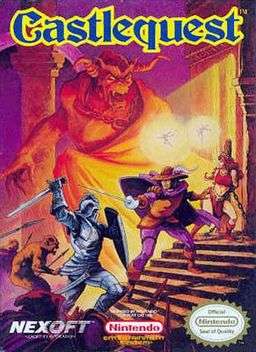Castlequest
| Castlequest Castle ExcellentJP | |
|---|---|
|
NES Box cover of Castlequest | |
| Developer(s) | ASCII Corporation[1] |
| Publisher(s) | ASCII Corporation, Nexoft Corporation[1] |
| Platform(s) | MSX, NES/Famicom |
| Release date(s) |
‹See Tfd› ‹See Tfd› |
| Genre(s) | Adventure/Puzzle |
| Mode(s) | Single-player |
Castlequest (known in Japan as Castle Excellent (キャッスルエクセレント Kyassuru Ekuserento)) is an adventure/puzzle-hybrid video game. It was developed and published by ASCII Corporation in 1985 for the FM-7, PC-88, and Sharp X1. Additional versions followed in 1986 for the Famicom and MSX, and was subsequently released in 1989 for the NES in the United States by Nexoft Corporation.
It is the sequel to The Castle, released in 1985 for the MSX, SG-1000, and other systems (though not the NES). Like that game, it is an early example of the Metroidvania genre.[2]
Gameplay
The object of the game is to navigate through Groken Castle to rescue Princess Margarita. The player can push certain objects throughout the game to accomplish progress. In some rooms, the prince can only advance to the next room by aligning cement blocks, Honey Jars, Candle Cakes, and Elevator Controlling Block. In some rooms, this can be quite time consuming since the prince can only open a particular door if he can stand by the door, meaning that he can not open the door while jumping in mid-air. The prince must also carry a key that matches the color of the door he intends to be open. The player can navigate the castle with the help of a map that can be obtained from the first room that he/she begins. The map will provide the player with a matrix of 10x10 rooms and will highlight the room in which the princess is located. The player must also avoid touching enemies like Knights, Bishops, Wizards, Fire Spirits, Attack Cats and Phantom Flowers.
Version differences
In the Family Computer and NES versions, each room is wider than the screen, so the display scrolls horizontally as the player moves. Because of the different room sizes, many adjustments to the room layouts were made in comparison to the MSX version. In the Family Computer version, the player starts with 4 lives, and the game supports the Famicom Data Recorder and ASCII Turbo File peripherals for saving and loading game progress. When the game was reworked for the US NES release, the save/load feature was removed (the NES does not have the 15-pin expansion port which the Turbo File connects to). However, the player has 50 instead of 4 lives initially. There are two magical fairies to help. Another obvious difference between the MSX and NES/Family Computer versions is that the player can attack enemies with his sword (or dagger) only in the NES/Family Computer versions. While this attack is limited because the enemy must be very close to the player for the kill to take place, which puts the player in the risk of being killed by the enemy because timing is crucial. The prince can dash and retrieve his weapon on a timely basis, and attacking in the wrong time can prevent the player from launching another attack when the enemy is in the right location to be attacked, leading to the certain loss of one life from the player. This scenario, however, is not relevant to the MSX version, since the only way to eliminate an enemy is to throw an object on it, or to force the enemy to climb an escalator and remain there until it is crushed to the ceiling.
References
- 1 2 3 4 Castlequest Info - Castlequest Information - Castlequest Release Date
- ↑ Pacheco, Márcio (June 23, 2016). "The Castle". GameHall. Retrieved July 14, 2016.
[O]s japas criaram uma mecânica de jogo que pode ser considerado o 'avô' de títulos como 'Super Metroid' e 'Castlevania: Symphony of the Night' . . . . “Castle Excellent” para MSX e NES, mantendo a mesma fórmula com algumas poucas diferenças.
External links
- Castlequest at MobyGames
- Gonzalez, Dan: Castlequest Instruction Manual.
